

Lynx is a modern constellation, invented by Hevelius in 1790, and has no mythological connections. It is a collection of dim stars nestling in between Leo Minor, Cancer, Gemini, Auriga, Camelopardalis, and Ursa Major.
Lynx is a faint constellation and it has been said that only those with eyes of a lynx can see anything there at all. It contains only one star brighter than 4th magnitude (3.1) which is also the only star to have a Bayer designation (α). It contains no Messier objects and only one NGC object of note. NGC2919 (Caldwell 25) is a globular cluster which subtends only 6.2 arc-minutes, not because it is small but because it is very remote at about 300,000 light-years from both us and the galactic centre. This is almost twice as far from the centre of the galaxy as Large Magellanic Cloud. At one time it was thought it might be escaping from the Milky Way to become what is known as an intergalactic tramp, but is now known to be approaching us at about 20 Km/sec.
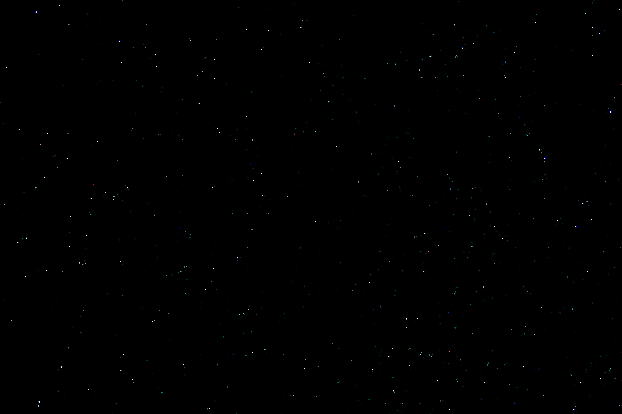
|
Usually I use a single exposure for these pictures but in this case I stacked four frames of exposures between 5 and 30 seconds taken with my Canon 1000D at f/4.5 ISO 1600. After removing the background light pollution, the stars show up very well in the original 3888×2592-pixel image but, when I reduce it to fit this page, all the dimmer stars disappear. So I reduce it in two stages, increasing either the gamma or the contrast and brightness after each reduction, in order to retain the dimmer stars. This has the unfortunate side-effect of reducing the contrast between stars of different magnitudes. In this case it gave me great difficulty identifying the stars but I hope they are correctly identified in the mouseover. You will notice, for example, that Castor and Pollux (α and β Geminorum) appear no brighter in my picture than the main stars of Lynx, even though they are between 2 and 3 magnitudes brighter. Move your mouse pointer over the image to see identifications of the major stars. Because Lynx is long and thin the picture includes stars from most of the surrounding constellations. In order to distinguish, I have used Bayer designations for the surrounding constellations and Flamsteed designations for the stars of Lynx. α-Lyncis is 40-Lyncis. |
Lynx has its share of multiple stars. 8- and 12-Lyncis are triples and some doubles are shown below.
 |
8-Lyncis is a very wide multiple star. The distance between the major components is about 6' 48", which is too much for my camera with these optics, so I had to make this picture as a mosaic and reduce it to 67% to fit this page. There are actually two more stars in the field. You can see these if you move your mouse pointer over the image when you will see a more-exposed and slightly enhanced version of the right-hand part of the picture at its original size. You will see two extra stars. None of these stars is physically associated with another. | |||
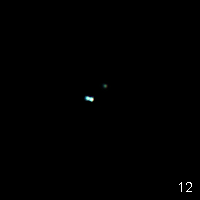 |
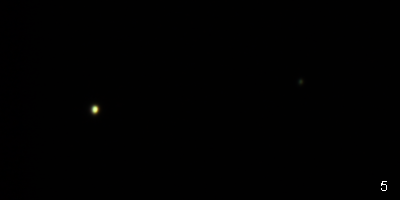 |
The separation of 12-Lyncis A and B is only 1.7 arc-seconds, so they are not easily separated. The separation of A and C is 8.5 arc-seconds. Their magnitudes are 4.9, 6.0, and 7.1. A and B are about 200 light-years away so that 1.7 arc-seconds corresponds to about 100 AU. The orbital period is 699 years. Component C is not connected. 5-Lyncis, on the other hand is an easy double with a separation of 95 arc-seconds. Their magnitudes are 5.2 and 7.9. |
||
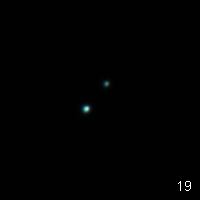 |
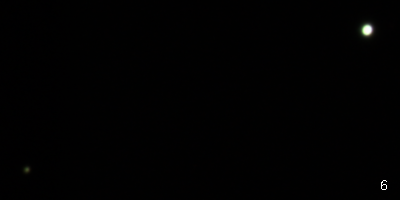 |
19 is actually a quadruple star (STF 1062). This pictures shows only components A and B, which are separated by 15 arc-seconds and are magnitude 5.5 and 6.5. Component C is faint (magnitude 11) and doesn't show in my picture. Component D is 215 arc-seconds north and well outside my picture. 6 is a widely separated double at 175 arc-seconds. The magnitudes are 5.9 and 9.4. |
||
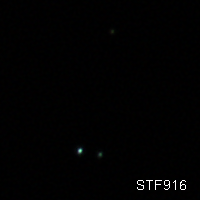 |
I imaged this star by chance. I was looking for 5-Lyncis and passed across this star so I took pictures. Then I had to work out which star it is. My telescope gave me coordinates of RA 6h 34m 48s Dec 56° 32' 51", but this is not completely accurate for various reasons. My best star atlas, Virtual Moon Atlas (CdC), shows no star at that location, nor any double star nearby. (It is not far from 11-Lyncis.) So I scanned the Struve list and found STF 916 which is listed as having three components with separations of 9.4 and 56.1 arc-seconds, A-B and A-C respectively. I measured my picture and found the separations to be 9.45 and 55.6 arc-seconds, a very pleasing agreement. The magnitudes are given as 9.5, 10.8, and 10.6. It is difficult to estimate magnitudes from these pictures, but one star is distinctly brighter than the other two which are themselves similar. STF 916 is located at 6h 34m 12s 56° 39', in reasonable agreement with my estimate. So all in all I am quite confident in my identification. I have been unable to find any other catalogue definition for this star (SAO, HD, HR etc.). | |||